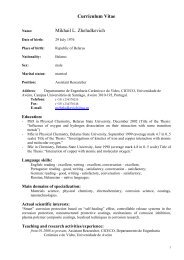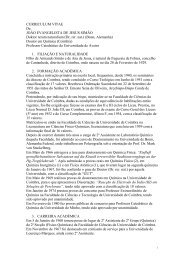XII Iberian Meeting of Electrochemistry XVI Meeting of the ...
XII Iberian Meeting of Electrochemistry XVI Meeting of the ...
XII Iberian Meeting of Electrochemistry XVI Meeting of the ...
You also want an ePaper? Increase the reach of your titles
YUMPU automatically turns print PDFs into web optimized ePapers that Google loves.
<strong>XII</strong> <strong>Iberian</strong> <strong>Meeting</strong> <strong>of</strong> <strong>Electrochemistry</strong> & <strong>XVI</strong> <strong>Meeting</strong> <strong>of</strong> <strong>the</strong> Portuguese Electrochemical Society PC 03<br />
Formation <strong>of</strong> mixed self-assembled monolayers <strong>of</strong> mono- and<br />
dithiols on Au(111)<br />
Rafael C. González-Cano, Rafael Madueño, Manuel Blázquez, Teresa Pineda<br />
Dpto. Química Física y Termodinámica Aplicada, Universidad de Córdoba, Córdoba, SPAIN<br />
tpineda@uco.es<br />
Alkanedithiolate self-assembled monolayers (SAMs) can form on Au(111) singlecrystal<br />
electrodes by <strong>the</strong> spontaneous formation <strong>of</strong> a strong gold-sulfur bond with one <strong>of</strong><br />
<strong>the</strong> SH terminal groups and <strong>the</strong> attractive van der Waals forces between adjacent alkyl<br />
chains. The control <strong>of</strong> <strong>the</strong> organization <strong>of</strong> <strong>the</strong>se architectures is <strong>of</strong> great technological<br />
importance, and <strong>the</strong> formation <strong>of</strong> well-organized layers is needed. In <strong>the</strong>se layers, <strong>the</strong><br />
second unreacted thiol moieties should<br />
be exposed to <strong>the</strong> outer surface [1,2].<br />
To obtain compact dithiol layers <strong>of</strong><br />
standing-up molecules, <strong>the</strong> use <strong>of</strong> a<br />
mixture <strong>of</strong> monothiol and dithiol<br />
derivatives at <strong>the</strong> appropriate relative<br />
concentrations that results in an<br />
almost pure dithiol film, have been<br />
reported [3]. In this work, we report<br />
on <strong>the</strong> formation <strong>of</strong> a mixed layer <strong>of</strong><br />
octanedithiol (ODT) and octanethiol<br />
(OT). The formation process is carried<br />
out under electrochemical control.<br />
Thus, an exploration <strong>of</strong> <strong>the</strong> different<br />
experimental conditions <strong>of</strong> ODT/OT<br />
molar ratio, electrochemical<br />
deposition potential and deposition<br />
time is described.<br />
Figure 1. Cyclic voltammograms for <strong>the</strong> oxidative deposition <strong>of</strong> ODT and OT layer in<br />
0.1 M NaOH solution on Au(111) single crystal electrode.<br />
In Figure 1, <strong>the</strong> oxidative deposition <strong>of</strong> ODT and OT in alkaline solutions are shown. It<br />
can be deduced that <strong>the</strong> different peak potentials will drive <strong>the</strong> formation <strong>of</strong> a mixed<br />
layer depending on <strong>the</strong> ratio <strong>of</strong> molecules employed.<br />
Acknowledgments: Project CTQ2007/62723, Junta de Andalucía and Universidad de Córdoba.<br />
References<br />
[1] García Raya, D.; Madueño, R.; Sevilla, J.M.; Blázquez, M.; Pineda, T.; Electrochim. Acta,<br />
2008, 53, 8026.<br />
[2] García Raya, D.; Madueño, R.; Blázquez, M.; Pineda, T.; J. Phys. Chem. C, 2010, 114, 3568.<br />
[3] Jiang, W. R.; Zhitenev, N.; Bao, Z. N.; Meng, H.; Abusch-Magder, D.; Tennant, D.; Garfunkel,<br />
E. Langmuir 2005, 21, 8751.<br />
September, 811, 2010. ISEL - Lisbon 81








